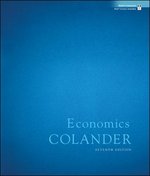Question
Q1.Jerry the repairman works in the town of Prattville.Jerry would prefer not to pay income tax on the revenues he receives in exchange for performing
Q1.Jerry the repairman works in the town of Prattville.Jerry would prefer not to pay income tax on the revenues he receives in exchange for performing household repairs.As such, he asks to be paid in cash by his clients whenever possible. If he is paid in cash, it makes it possible for him not to report the income and so to evade income tax. Suppose that his gain for not reporting his cash income is 10. If he does not report his income when he has been paid by check, however, he can anticipate a loss due to fines of 50.His clients prefer to pay by check since this does not require them to lose time going to the bank each time they call the repairman. The clients face a loss in terms of inconvenience of 5 when they pay by cash.
a. Depict the "game" played by Jerry and a representative client where the possible moves by Jerry are to "report" or "not report" income while the possible moves by the client are to pay in "cash" or "check".What is/are the Nash equilibrium of this game? Does the government collect any tax revenue at this equilibrium? Explain with payoff matrix.
b. The government now introduces a Value Added Tax (VAT) to be added onto the amount paid by the client when repair services are received.Jerry suggests the following to his clients: "If you pay me in cash, we will not increase the bill by the amount of the VAT. This will result in a payoff to you of 5. If you pay me by check, we must add the VAT to the amount of the bill." Show how the introduction of the VAT changes the payoffs in the game matrix of part (a). What is/are the new Nash equilibrium of this game? Does the government's tax revenue go up when the VAT is introduced? Explain with payoff matrix. Q2. Outer Ziconia is a largely rural country with many small towns. Each town typically contains a retail store selling livestock feed. In virtually all towns, there is only one such store. The farmers who purchase feed from these stores typically live outside of town, sometimes at a significant distance. Often, they will purchase from a store in the town closest to them, but if farmers learn through word of mouth that a feed retailer in a more distant town is selling feed at a significantly lower price, they will sometimes go to that store to obtain feed.
The country-wide market shares of the six largest feed stores in Outer Ziconia are shown in the table below:
| Firm | Market Share |
| Ben's Feed and Supplies | 5% |
| Joe's Hog and Cattle Supply | 2% |
| Hogwarts | 2% |
| Dave's Livestock and Tools | 0.50% |
| Ron's Supply shed | 0.25% |
| Eddie's Feed Coop | 0.25% |
a. What is the four-firm (4CR) concentration ratio for the livestock feed store market in Outer Ziconia? Explain its relevance. b. What is the (approximate) Herfindahl-Hirschman Index (HHI) for this industry? Explain its relevance. c. Which market structures best describes the livestock feed market in Outer Ziconia? Justify in detail. Support your justification with suitable diagram/s. Q3. The startup founders of 'Barbeque-India' are seeking your support to plan the launch of the dine-in food chain as of now, restricting to North India. They are eager to know if they can charge high prices for their menus, even if the competition in restaurant industry looks tight. In the Indian restaurant market, do we find characteristics of oligopoly competition? Or can we consider the restaurant market as a monopolistic competition? Guide them about the pricing practices based on your understanding about the market dynamics. What kind of economic profits restaurant business expect in the long run? Justify. Support your justification with suitable diagram/s. Q4. (a) With first-degree price discrimination, why is the marginal revenue curve the same as the demand curve? Support your answer with suitable diagram/s. (b) Suppose a company is currently charging a uniform price for its two products, creamy and crunchy peanut butter. Will third-degree price discrimination necessarily improve its profit? Would the firm ever be worse off with price discrimination? Support your justification with suitable diagram/s. c). Deliberate price discrimination in the airline industry. What you do expect to be the major impact of 'Akasa' an upcoming "ultra low-cost carrier", being launched by stock market investor RakeshJhunjhunwala on the airline industry in future. Critically evaluate. Support your answer with suitable diagram/s.
Step by Step Solution
There are 3 Steps involved in it
Step: 1

Get Instant Access to Expert-Tailored Solutions
See step-by-step solutions with expert insights and AI powered tools for academic success
Step: 2

Step: 3

Ace Your Homework with AI
Get the answers you need in no time with our AI-driven, step-by-step assistance
Get Started


